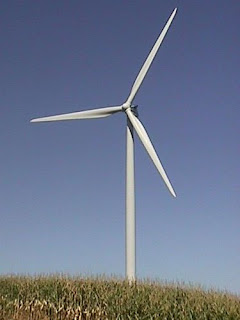 Matt Joyce has a story posted on Trib.com that delves into what may become a very contentious legal issue in the future as alternative energy production increases nationwide. The questions is over “the nature of wind rights and how they relate to land ownership.” Wyoming is currently considering this very issue as wind farm development continues in the state.
Matt Joyce has a story posted on Trib.com that delves into what may become a very contentious legal issue in the future as alternative energy production increases nationwide. The questions is over “the nature of wind rights and how they relate to land ownership.” Wyoming is currently considering this very issue as wind farm development continues in the state.There is a general agreement among Wyoming lawyers that the owner of the “surface of the land also owns the rights to develop wind resources.” However, the legislature in Wyoming has not explored whether or not these rights can be severed as they can be with mineral rights in the state.
Lynne Boomgaarden, the director of the Office of State Lands and Investments had this to say about the issued, ‘“The prevailing thought is yes they can (be severed . . . for the reason that wind is a commodity that has value as do the minerals below the surface of the land, and you can severe the minerals." Federal law has not provided an answer to the severing question, but nearby states (South Dakota, North Dakota, and Nebraska) have all enacted statutes tying the wind rights to the land surface estate. The South Dakota statute was enacted as far back as 1996.
Steve Wegman, executive director of the South Dakota Wind Energy Association describes the prevailing issues around severing the rights thusly in the Joyce story, ‘“If you sever the wind rights, you really have no control over the surface of the land . . . It'd be like me coming over to your house and building a cell tower or radio tower, and I take my annual payment for that tower and I move to Florida, and you're stuck with that as long as you own that property.”’
Boomgaarden acknowledges the complications that could arise from having to negotiate the different rights and uses of the land should the wind rights be severed. Additionally, Boomgaarden says, ‘“If the wind rights stay with the surface rights, there is an incentive for that surface owner to accommodate or optimize the number of uses on that surface, be it agriculture, wind, mining (and) mineral uses of the surface[.]”’
Since he has heard examples of Wyoming land owners splitting their surface and wind rights, professor of energy law at the University of Wyoming, Dennis Stickley, thinks it would be prudent of the legislature to address the issue of whether or not such severance should be legal. As Stickley is quoted in the Joyce story, ‘“They've given it attention in the case of water rights, mineral rights, pore space rights, so it's certainly an appropriate subject for the Legislature to deal with . . . These issues will have to be settled. We could settle it through debate in the Legislature or we'll settle in the courts. The issues won't go away.’”
There is some convincing that remains to be done if the issue will be addressed this legislative session. According to Sen. Jim Anderson (R-Glenrock), the chairman of a legislative task force studying wind laws, the task force recommendations would just be for further research.
Without an answer from the state legislature, and no recommendations from the federal government, the issue may be decided by the courts in Wyoming before the legislature even gets a say.


